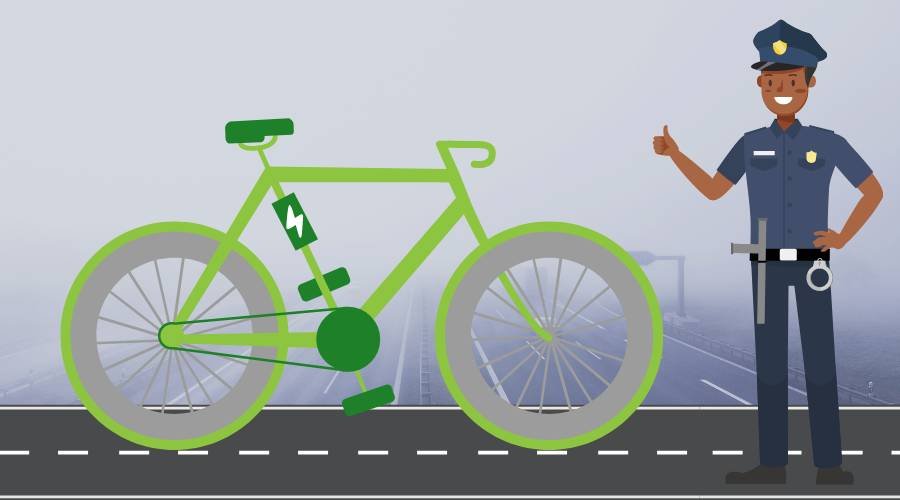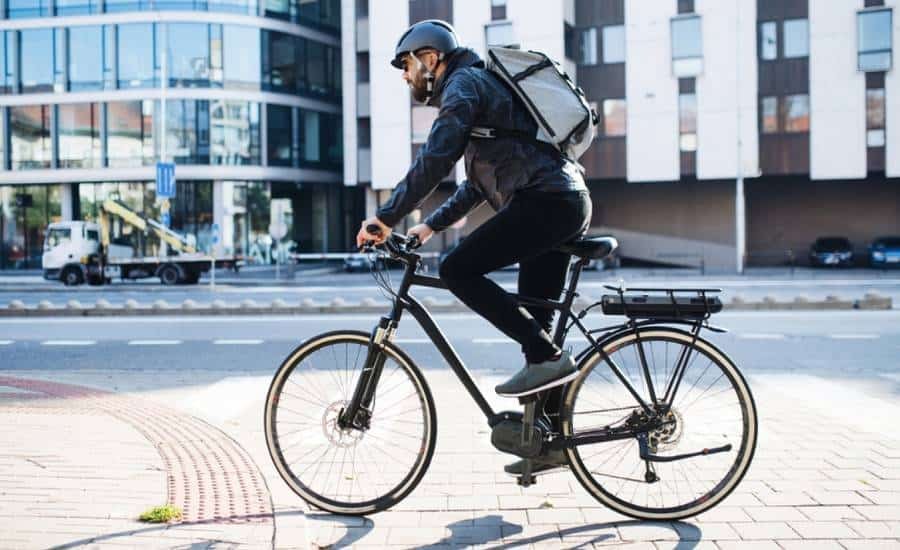Are you considering buying an electric bike but wondering if it’s legal to ride it on the streets? It’s a common concern among potential buyers, and for good reason. According to a recent study, the global e-bike market is projected to reach $52.37 billion by 2030, and with that growth comes a need for clarification on the legality of electric bikes.
The problem is that the laws surrounding e-bikes can vary significantly from state to state and country to country. In some places, electric bikes are treated as regular bicycles, while in others, they may require a license or registration.
In this post, we’ll explore the question of whether electric bikes are street legal and provide context on the different regulations and restrictions that may apply to e-bike riders. It’s essential information for anyone considering purchasing an electric bike, as well as for those already riding them. Let’s dive in.
What Does Street Legal Mean?

You’re not alone if you’ve been curious about what “street legal” means for electric bikes. It boils down to rules and regulations these bikes must follow to be ridden on public roads and highways.
The rules around electric bikes vary depending on where you are, but generally, they are classified as either regular bicycles or motor vehicles. Bicycles are usually allowed to ride in bike lanes and on bike paths, while motor vehicles must comply with stricter regulations and might require a license or registration.
For electric bike riders, you must follow the same traffic rules as other vehicles when riding on public roads. This includes stopping at traffic signals, indicating when you’re turning, and following speed limits. In addition, if your electric bike is classified as a motor vehicle, you might also need a special license or registration to ride it legally.
Manufacturers of electric bikes also need to ensure their bikes meet certain specifications to be considered street-legal. This includes maximum speed, motor power, and braking capabilities. Overall, the term “street legal” for electric bikes is all about ensuring that these bikes are safe and legal to ride on public roads.
Are Ebikes Legal?
Have you ever wondered whether e-bikes are legal or not? They’re getting increasingly popular, thanks to their environmental friendliness, low cost, and easy operation. But the laws surrounding their use can be confusing and vary from place to place.
Overall, e-bikes are legal in most countries, but there are some limits on their power and speed. In the United States, electric bicycles are allowed to have a motor with a maximum power of 750 watts and can travel up to 20 miles per hour.
E-bikes are subject to the same rules as regular bicycles. Therefore, you can ride them on bike paths and bike lanes, but not on highways. Additionally, you don’t need a license or insurance to operate an e-bike.
However, the regulations differ by state, and some e-bikes can be subject to extra restrictions. For example, only Class 1 and Class 2 e-bikes are allowed in New York, but not Class 3. You may also have to wear a helmet in some states but not in others.
It’s worth remembering that even though e-bikes are legal, they have to follow the same safety and traffic rules as regular bikes. This includes wearing helmets, signaling when turning, and using lights at night.
What Are the Laws Governing Electric Bikes?

E-bike laws can vary depending on where you’re located, so it’s important to do some research before hitting the road. In some parts of Europe, you can cruise along bike paths and lanes just like traditional bikes, but in other countries like Germany, there may be more restrictions if your e-bike exceeds certain speed or power limits.
In the US and Canada, federal laws classify e-bikes as bicycles as long as they meet certain criteria, but there may be additional rules and regulations depending on your state or province. It can be a bit overwhelming, but it’s worth taking the time to understand the laws in your area so you can ride safely and legally.
At the end of the day, no matter where you are, it’s always a good idea to be courteous to other road users and follow traffic laws. Whether you’re stopping at red lights, yielding to pedestrians, or wearing a helmet, taking a few extra precautions can go a long way toward making the roads safer for everyone.
How to Determine if Your Electric Bike is Street Legal
Before you hit the streets with your electric bike, it’s essential to know if it’s street-legal. It’s not just about complying with the law but also about safety. There are different rules and regulations depending on where you live, so you must do your homework to avoid unnecessary hassles.
The first thing you should do is check your local laws and regulations. Look for rules on where you can ride and what features your electric bike needs to have to be considered legal. For example, some places treat electric bikes as regular bicycles, while others require more stringent rules.
Regarding the power of your electric bike, most places have a 750-watt limit and a maximum speed of 20 miles per hour. If your electric bike exceeds these limits, you might need a special license or registration to ride on public roads.
Remember the pedals! Some states require functional pedals on electric bikes, even if you use only the electric motor to move the bike. This ensures you can pedal your way to your destination if your battery runs out of juice.
Finally, ensure your electric bike has all the necessary safety features, such as working headlights, taillights, reflectors, and brakes. Some places also require a horn or bell, so remember to check.
Where Am I Allowed To Ride My E-bike?

In general, e-bikes are treated like traditional bikes, which means you can usually ride them on bike paths, bike lanes, and the road. However, it’s essential to keep in mind that there are some restrictions that you need to know.
One of the most important things to consider is the speed of your e-bike. If your bike can go faster than the posted speed limit, you may not be allowed to ride it on bike paths or bike lanes. Additionally, if your e-bike is throttle-powered instead of pedal-assisted, there may be different rules that apply to you.
It’s worth noting that e-bike regulations can vary depending on where you live. Different states and countries may have different laws governing e-bike usage, so it’s always a good idea to check with your local authorities to ensure you’re following the rules.
Can I Use an Electric Bike on the Road?
If you’re considering buying an electric bike, one of the big questions is whether it’s legal to ride it on the road. The answer is generally yes, but there are a few things to remember.
First, it’s important to remember that electric bikes differ from electric motorcycles or mopeds. Electric bikes are typically lighter and have smaller motors than those vehicles. However, most places consider them similar to regular bicycles, meaning you can ride them on the road, on bike lanes, and on bike paths.
However, you may need to follow specific rules, depending on where you live. For instance, some states or countries have speed limits for electric bikes or restrictions on motor power. It’s also important to check if you need a license, registration, or insurance to ride an electric bike in your area.
When it comes to safety, it’s always a top priority. Just because you’re allowed to ride an electric bike on the road doesn’t mean it’s automatically safe. You should always wear a helmet and follow traffic laws. It’s imperative to stay alert and cautious when you’re riding in traffic or on busy roads.
Can You Ride Electric Bike on Pavement?

It can be confusing because the rules vary depending on where you are. In some places, it’s totally fine, while in others, it’s a big no-no.
In the US, federal law regulates electric bikes, but it’s up to each state to decide on the specifics. Some states let you ride on sidewalks, while others don’t. For instance, in California, you can’t ride your electric bike on the pavement, but you can ride on the road or bike lanes.
The critical thing is to always check local laws before you ride your electric bike on the pavement. If it’s not allowed in your area, you could end up with a fine or even legal action taken against you.
Many people feel nervous when it comes to riding electric bikes on the road, so they often choose to ride on the pavement instead. However, it’s essential to remember that if riding on the pavement is against the rules, it’s simply not an option.
While we understand that electric bikes can be bulky and challenging to manage, we should always prioritize the safety of pedestrians. At the end of the day, it’s up to us to follow the rules and take care not to bump into anyone while enjoying our electric bike rides!
Do I Need a License to Ride an Electric Bicycle?
The answer depends on where you live and the bike’s specifications. For example, in the US, you don’t need a license to ride an electric bike with a maximum power of 750 watts and a top speed of 20 mph. But it’s always a good idea to check your local regulations, as they can vary depending on the state or city.
Even if a license isn’t required, it’s important to remember that you still need to follow the rules of the road, such as wearing a helmet, signaling, and using lights at night. And if you’re thinking of making any modifications to your electric bike, be careful not to exceed the legal limits on speed and power, as this could require a license or registration.
Do You Need a Helmet for an Electric Bike?

Well, the answer to this question varies depending on your age, the speed and power of your bike, and the laws in your state or country. For instance, in most US states, those under 18 must wear helmets. In addition, some states, like California and New York, require all riders to wear helmets. However, in other states like Colorado and Virginia, only riders under 17 or 14 must wear helmets.
Regardless of the laws, it is always wise to wear a helmet when riding an electric bike. These bikes can reach higher speeds, and accidents can have severe consequences. A helmet can protect your head and brain from serious injury, so it’s always best to err on caution. When choosing a helmet, ensure it is comfortable, fits well, and meets safety standards set by organizations like the Consumer Product Safety Commission. A well-fitted helmet can be a lifesaver in the event of an accident.
Safety Considerations for Riding Electric Bikes on Public Roads
Firstly, always wear a helmet that fits you properly. While most e-bikes don’t go very fast, accidents can still happen, and head injuries can be severe. So it’s not only the law in many places but also a smart choice for your protection.
Secondly, ensure that your e-bike has appropriate lights and reflectors. This is particularly important if you plan to ride in low-light conditions or at night. Ensure your headlight is bright and visible and your bike has reflectors on the sides and back.
Thirdly, follow traffic rules and regulations. That means stopping at red lights, using hand signals when turning, and giving way to pedestrians. Be mindful of the speed limit, and don’t go too fast.
Lastly, staying visible to other drivers, cyclists, and pedestrians is crucial. Wear bright, reflective clothing and avoid riding in areas with limited visibility. Assume that others on the road may not see you and ride defensively.
FAQs
What determines if an electric bike is street-legal?
It depends on the laws and regulations in your specific country or state.
How fast can an electric bike go and still be street-legal?
Again, this varies by location. In the United States, electric bikes are generally street legal if they have a maximum speed of 20 mph (32 kph) or less.
Do I need a license to ride an electric bike on the street?
Electric bikes are generally classified as bicycles, so you don’t need a special license to ride them.
Are there any age restrictions for riding electric bikes on the street?
This can vary by location, but there are no age restrictions for riding electric bikes in many places.
Are electric bike riders required to wear helmets?
This also depends on the location. In many places, helmet laws for electric bike riders are the same as for traditional bicycles.
Can I ride an electric bike on bike paths and parks?
This can vary by location. For example, in some places, electric bikes are allowed on bike paths and parks, while in others, they are not.
Can I modify my electric bike to make it faster and still be street-legal?
Modifying an electric bike to exceed the maximum speed limit set by law would likely make it no longer street-legal.
Are there any other regulations I should be aware of when riding an electric bike on the street?
It’s essential to familiarize yourself with the laws and regulations in your specific location, as they can vary widely. In addition, some places may have specific requirements for electric bike safety features or equipment.

